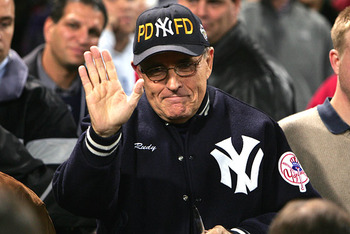|
Is there a more foolish display by public officials than the mandatory Super Bowl wager between mayors or governors? Are they so craven that they need the attention?
Phil Taylor of Sports Illustrated, one of the most thoughtful voices among American sports columnists, has a great point this week. He wishes politicians would butt out of sports, particularly those public figures who don’t know a thing about them. Once again, Taylor has done his homework, citing ludicrous examples of politicians who were clearly pandering, out of their element. A rare example of bipartisanship: clearly, over-reaching knows no political boundary. Yet my home town of New York has had two recent mayors who took diametrically opposite positions toward sports, and both worked, for them. Rudy Giuliani made no secret of rooting for his Yankees, whereas Ed Koch had a visceral disinterest in anything sporty. Giuliani wore his Yankee jacket and cap, was a frequent visitor to the Stadium, knew the players, and knew the game. He was delighted that his position as mayor could get him up close to the field. The Yankees won five pennants and four World Series during his regime. He showed up for the sixth game in Arizona in early November of 2001. Given what he had been through back home in the two previous months, he had every right to follow his team. The next morning he was back in New York at the start of the Marathon – another statement that the city would endure, that nihilists and lunatics could not shut us down. Then he flew back to Phoenix for the seventh game that night. “You’re sick,” I said to him in the crush of the deflated clubhouse after the loss. Giuliani understands clubhouse talk. He smiled and shrugged. It was his team, and he was there, to whisper support to Mariano Rivera, to praise the winning team. “''I appreciate the way we were treated,'' Giuliani said. ''And if you have to lose, it's better to lose to a city like this. These people sent us search-and-rescue crews.'' Giuliani would show up at Shea Stadium on opening days or other important moments, pay his respects to the Mets and their fans. But everybody understood. He was a Yankee fan. He had earned that right. Rudy Giuliani was never more appealing than when he rooted for his team. Koch could care less, as we say in New York. He had no interest in sports. If his top aides say, Mr. Mayor, you have to go to opening day, he would allow himself to be whisked out of Manhattan into one outer borough or another, where he would be introduced, endure the obligatory boos, and take a seat for an inning or two. Hizzoner might have stayed longer if the ballparks had included an outpost for some Peking duck emporium. But around the third inning, you would glance down at the box seats, and there would be a gap in the spectators. While the teams changed sides, the mayor had bolted for the exit; the limo was taking him back to the safety and the aromas of downtown. But he never faked it, never talked manly jock talk, never pretended to know who played first base for the Yankees or Mets. I think the estimable Phil Taylor would agree: (strictly in a sports context) if you can’t be Rudy Giuliani, then by all means be Ed Koch. And politicians: have you no dignity? Stop with the wagers. 7/28/2013 09:15:44 pm
The most important quality of a lawyer is obviously that they have to have a good understanding of the law. This may seem obvious but it is something that a lot of people really don't think about when they are hiring a lawyer. Comments are closed.
|
Categories
All
|










